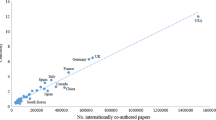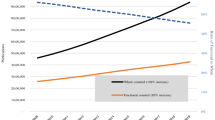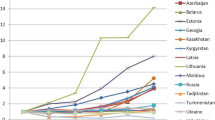Abstract
Using co-authored publications between China and Korea in Web of Science (WoS) during the one-year period of 2014, we evaluate the government stimulation program for collaboration between China and Korea. In particular, we apply dual approaches, full integer versus fractional counting, to collaborative publications in order to better examine both the patterns and contents of Sino-Korean collaboration networks in terms of individual countries and institutions. We first conduct a semi-automatic network analysis of Sino-Korean publications based on the full-integer counting method, and then compare our categorization with contextual rankings using the fractional technique; routines for fractional counting of WoS data are made available at http://www.leydesdorff.net/software/fraction. Increasing international collaboration leads paradoxically to lower numbers of publications and citations using fractional counting for performance measurement. However, integer counting is not an appropriate measure for the evaluation of the stimulation of collaborations. Both integer and fractional analytics can be used to identify important countries and institutions, but with other research questions.





Similar content being viewed by others
Notes
The search string “CU = Korea AND PY = 2014” retrieves 63,833 records, of which 63,806 (>99.9 %) has an address in South Korea and 28 in North Korea. Since this adds up to 63.834, obviously one paper was co-authored by North and South Koreans. However, one can also search with “CU = South Korea” in the database. The search “CU = (South Korea AND China) AND PY = 2014” retrieved 2765 records on January 19, 2016.
References
Abbasi, A., Chung, K. S. K., & Hossain, L. (2012). Egocentric analysis of co-authorship network structure, position and performance. Information Processing and Management, 48(4), 671–679.
Anderson, J., Collins, P. M. D., Irvine, J., Isard, P. A., Martin, B. R., Narin, F., & Stevens, K. (1988a). On-line approaches to measuring national scientific output: A cautionary tale. Science and Public Policy, 15(3), 153–161.
Anderson, J., Collins, P. M. D., Irvine, J., Isard, P. A., Martin, B. R., Narin, F., & Stevens, K. (1988b). On-line approaches to measuring national scientific output: A cautionary tale. Science and Public Policy, 15(3), 153–161.
Aziz, N. A., & Rozing, M. P. (2013). Profit (p)-index: The degree to which authors profit from co-authors. PLoS ONE, 8(4), e59814.
Bornmann, L. (2014). Do altmetrics point to the broader impact of research? An overview of benefits and disadvantages of altmetrics. Journal of Informetrics, 8(4), 895–903.
Brandes, U. (2008). On variants of shortest-path betweenness centrality and their generic computation. Social Networks, 30(2), 136–145.
Braun, T., Glänzel, W., & Schubert, A. (1989). Assessing assessments of British science. Some facts and figures to accept or decline. Scientometrics, 15(3), 165–170.
Choi, S., Yang, J. S., & Park, H. W. (2015a). Quantifying the triple helix relationship in scientific research: Statistical analyses on the dividing pattern between developed and developing countries. Quality & Quantity, 49(4), 1381–1396.
Choi, S., Yang, J. S. W., & Park, H. W. (2015b). The triple helix and international collaboration in sciences. Journal of the Association for Information Science and Technology, 66(1), 201–212.
Dekker, D., Krackhardt, D., & Snijders, T. A. (2007). Sensitivity of MRQAP tests to collinearity and autocorrelation conditions. Psychometrika, 72(4), 563–581.
Delgado, E., & Repiso, R. (2013). The impact of scientific journals of communication: Comparing Google Scholar metrics, Web of Science and Scopus. Comunicar, 41, 45–52.
Egghe, L. (2008). Mathematical theory of the h-and g-index in case of fractional counting of authorship. Journal of the American Society for Information Science and Technology, 59(10), 1608–1616.
Freeman, L. C. (1979). Centrality in social networks conceptual clarification. Social Networks, 1(3), 215–239.
Galam, S. (2010). Integrating multiple coauthorship in the quantitative evaluation of individual’s scientific records. Arxiv preprint arXiv:1007.3708.
Garfield, E. (1979). Is citation analysis a legitimate evaluation tool? Scientometrics, 1(4), 359–375.
Gautam, P., Kodama, K., & Enomoto, K. (2014). Joint bibliometric analysis of patents and scholarly publications from cross-disciplinary projects: Implications for development of evaluative metrics. Journal of Contemporary Eastern Asia, 13(1), 19–37.
Gruzd, A., Staves, K., & Wilk, A. (2012). Connected scholars: Examining the role of social media in research practices of faculty using the UTAUT model. Computers in Human Behavior, 28(6), 2340–2350.
Hanneman, R. A., & Riddle, M. (2005). Introduction to social network methods. CA: University of California, Riverside. Retrieved July 1, 2013 from http://faculty.ucr.edu/~hanneman.
Holmberg, K. (2015). Altmetrics for information professionals: Past, present, and future. Waltham, MA: Chandos Publishing.
Irvine, J., & Martin, B. R. (1986). Is Britain spending enough on science? Nature, 323, 591–594.
Irvine, J., Martin, B., Peacock, T., & Turner, R. (1985). Charting the decline of British science. Nature, 316, 587–590.
Khan, G. F., Moon, J. H., Park, H. W., Swar, B., & Rho, J. J. (2011). A socio-technical perspective on e-government issues in developing countries: A scientometrics approach. Scientometrics, 87(2), 267–286.
Kim, L., & Park, H. W. (2015). Diagnosing “collaborative culture” of biomedical science in South Korea: Misoriented knowledge, competition and failing collaboration. East Asian Science, Technology and Society: An International Journal., 9, 1–21.
King, G. (2011). Ensuring the data-rich future of the social sciences. Science, 331(6018), 719–721.
Korea Research Foundation. (2014). 2014 ECSAC-Korea Journal Editors Workshop. Daejeon: Korea Research Foundation.
Kuhn, T. S. (1970). The structure of scientific revolutions. Chicago: Chicago University Press.
Kwon, K. S., Park, H. W., So, M. H., & Leydesdorff, L. (2012). Has globalization strengthened South Korea’s national research system? National and international dynamics of the Triple Helix of scientific coauthorship relationships in South Korea. Scientometrics, 90(1), 163–176.
Lee, K. (2014). Schumpeterian analysis of economic catch-up. Cambridge: Cambridge University Press.
Lemarchand, G. A. (2012). The long-term dynamics of co-authorship scientific networks: Iberoamerican countries (1973–2010). Research Policy, 41(2), 291–305.
Leydesdorff, L. (1988). Problems with the ‘measurement’ of national scientific performance. Science and Public Policy, 15(3), 149–152.
Leydesdorff, L. (1989). The Science Citation Index and the measurement of national performance in terms of numbers of publications. Scientometrics, 17, 111–120.
Leydesdorff, L. (2015). The sciences are discursive constructs: The communication perspective as an empirical philosophy of science. In L. Cantoni & J. A. Danowski (Eds.), Communication and Technology (pp. 553–562). Berlin and Boston: De Gruyter Mouton.
Leydesdorff, L., Park, H. W., & Wagner, C. (2014). International coauthorship relations in the Social Sciences Citation Index: Is internationalization leading the Network? Journal of the Association for Information Science and Technology, 65(10), 2111–2126.
Leydesdorff, L., & Shin, J. C. (2011). How to evaluate universities in terms of their relative citation impacts: Fractional counting of citations and the normalization of differences among disciplines. Journal of the American Society for Information Science and Technology, 62(6), 1146–1155.
Leydesdorff, L., Wagner, C., Park, H. W., & Adams, J. (2013). International collaboration in science: The global map and the network. El professional de la información., 22(1), 87–94.
Martin, B. R. (1991). The bibliometric assessment of UK scientific performance—A reply to Braun, Glänzel and Schubert. Scientometrics, 20, 333–357.
Mehmood, A., Choi, G. S., & von Feigenblatt, O. F., & Park, H. W. (2016 accepted). Proving ground for social network analysis in the emerging research area “Internet of Things” (IoT). Scientometrics. doi:10.1007/s11192-016-1931-4.
Moed, H. F. (2000). Bibliometric indicators reflect publication and management strategies. Scientometrics, 47(2), 323–346.
Moed, H. F. (2010). Measuring contextual citation impact of scientific journals. Journal of Informetrics, 4(3), 265–277.
Morris, S. A. (2005). Unified Mathmatical Treatment of Complex Cascaded Bipartite Networks: The Case of Collections of Journal Papers. Oklahoma State University. Retrieved from http://digital.library.okstate.edu/etd/umi-okstate-1334.pdf. Unpublished Ph.D. Thesis.
Mosbah-Natanson, S., & Gingras, Y. (2013). The globalization of social sciences? Evidence from a quantitative analysis of 30 years of production, collaboration and citations in the social sciences (1980–2009). Current Sociology,. doi:10.1177/0011392113498866.
Narin, F. (1976). Evaluative bibliometrics: The use of publication and citation analysis in the evaluation of scientific activity. Washington, DC: National Science Foundation.
Park, H. W., & Leydesdorff, L. (2010). Longitudinal trends in networks of university–industry–government relations in South Korea: The role of programmatic incentives. Research Policy, 39(5), 640–649.
Park, H. W., & Leydesdorff, L. (2013). Decomposing social and semantic networks in emerging “big data” research. Journal of Informetrics, 7(3), 756–765. doi:10.1016/j.joi.2013.05.004.
Rana, S. (2012). Bibliometric analysis of output and visibility of science and technology in Singapore during 2000–2009. Webology, 9(1), Article 96. http://www.webology.org/2012/v9n1/a96.html.
Shapiro, M., & Park, H. W. (2012). Regional development in South Korea: Accounting for research area in centrality and networks. Scientometrics, 90(1), 271–287.
Shapiro, M., So, M. H., & Park, H. W. (2010). Quantifying the national innovation system: Inter-regional collaboration networks in South Korea. Technology Analysis & Strategic Management, 22(7), 845–857.
Small, H., Sweeney, E., & Greenlee, E. (1985). Clustering the science citation index using co-citations II. Mapping science. Scientometrics, 8, 321–340.
So, M., Kim, J., Choi, S., & Park, H. W. (2015). Factors affecting citation networks in science and technology: Focused on non-quality factors. Quality & Quantity, 49(4), 1513–1530. doi:10.1007/s11135-014-0110-z.
Song, M., Yang, C., & Tang, X. (2013). Detecting evolution of bioinformatics with a content and co-authorship analysis. SpringerPlus, 2(1), 186. doi:10.1186/2193-1801-2-186.
Sun, J., & Jiang, C. (2014). Sino-South Korean Scientific collaboration based on co-authored SCI papers. Journal of Information Science Theory and Practice, 2(1), 48–61.
Tanksalvala, S. (20 October, 2014). Web of Science now includes expanded coverage of top Korean journals. Web of Sceicne. http://endnote.com/blog/web-science-now-includes-expanded-coverage-top-korean-journals.
Thelwall, M. (2008). Extracting accurate and complete results from search engines: Case study Windows Live. Journal of the American Society for Information Science and Technology, 59(1), 38–50.
UNESCO. (2015). UNESCO Science report-towards 2030. Paris: UNESCO Publishing.
van Liere, D. (2004). Interpretation of UCINET Output. Essex Summer School Version 1.0.
Van Noorden, Richard. (2014). Online collaboration: Scientists and the social network. Nature, 512, 126–129.
Velez-Cuartas, G., Lucio-Arias, D., & Leydesdorff, L. (2016, forthcoming). Regional and global science: Latin American and Caribbean publications in the SciELO Citation Index and the Web of Science. El Profesional de la Información; preprint at arXiv:1510.02453.
Wagner, C. S., Park, H. W., & Leydesdorff, L. (2015). The continuing growth of global cooperation networks in research: A conundrum for national governments. PLoS One, 10(7), e0131816. doi:10.1371/journal.pone.0131816.
Waltman, L., & van Eck, N. J. (2015). Field-normalized citation impact indicators and the choice of an appropriate counting method. Journal of Informetrics, 9(4), 872–894.
Yang, C. H., Park, H. W., & Heo, J. (2010). A network analysis of interdisciplinary research relationships: The Korean government’s R&D grant program. Scientometrics, 83(1), 77–92.
Yoon, J. W., & Park. H. W. (2016 Accepted). Triple helix dynamics of South Korea’s innovation system: A network analysis of inter-regional technological collaborations. Quality & Quantity. doi:10.1007/s11135-016-0346-x.
Yoon, J., Yang, J. S., & Park, H. W. (2015). Triple helix patterns and dynamics in Korea–China scientific collaborations. Daegu, Korea: Presented to the DISC.
Zheng, J., Zhao, Z. Y., Zhang, X., Chen, D. Z., Huang, M. H., Lei, X. P., et al. (2012). International scientific and technological collaboration of China from 2004 to 2008: A perspective from paper and patent analysis. Scientometrics, 91, 65–80.
Zhou, P. & Leydesdorff, L. (2016). A comparative study of the citation impact of Chinese journals with priority funding. Presented to 1st international symposium on webometrics, informetrics & scientometrics (ISWIS) 17 October, 2015 Zhejiang University, Hangzhou, China. Frontiers in Research Metrics and Analytics.
Zhou, Q., Leng, F., & Leydesdorff, L. (2015). The reflection of hierarchical cluster analysis of co-occurrence matrices in SPSS. Chinese Journal of Library and Information Science, 8(2), 11–24.
Zitt, M. (2006). Delineating complex scientific fields by an hybrid lexical-citation method: An application to nanosciences. Information Processing and Management, 42(6), 1513–1531.
Author information
Authors and Affiliations
Corresponding author
Rights and permissions
About this article
Cite this article
Park, H.W., Yoon, J. & Leydesdorff, L. The normalization of co-authorship networks in the bibliometric evaluation: the government stimulation programs of China and Korea. Scientometrics 109, 1017–1036 (2016). https://doi.org/10.1007/s11192-016-1978-2
Received:
Published:
Issue Date:
DOI: https://doi.org/10.1007/s11192-016-1978-2




